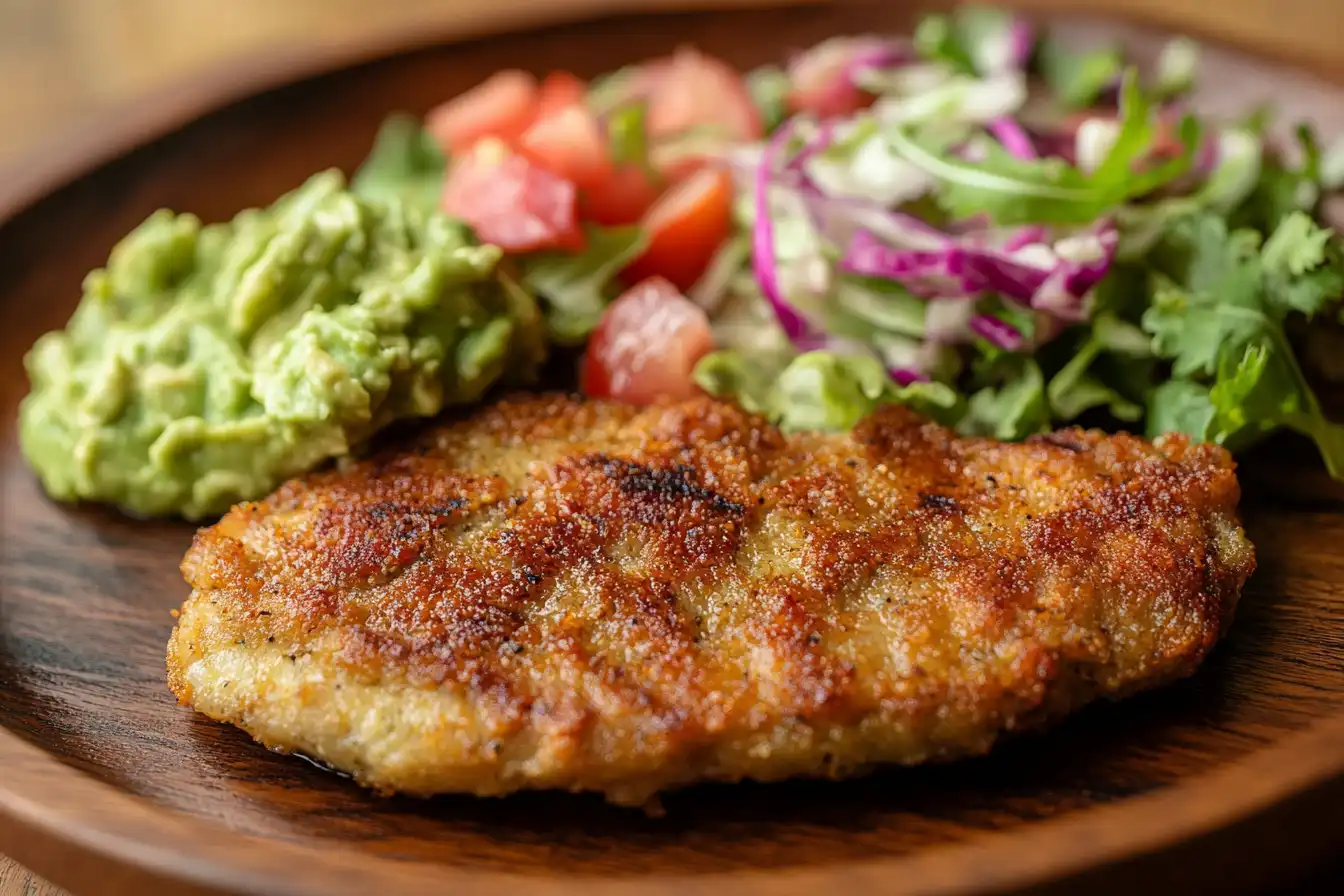Introduction
When it comes to crispy, golden-brown comfort food, milanesa steak often takes center stage. This classic dish, a staple in Mexican and Latin American cuisine, has become a beloved favorite around the world. One question that often arises is, Is milanesa steak tender to eat? Whether you’re a culinary enthusiast or someone new to this delightful dish, understanding its preparation, texture, and how to achieve optimal tenderness is essential.
This article explores everything you need to know about milanesa steak, from its origins to the techniques that make it irresistibly tender. You’ll also learn about its characteristics, serving ideas, and even some pro tips to elevate your cooking game. Let’s dive into the juicy details!
Introduction to Milanesa Steak
What is Milanesa Steak?
Milanesa steak is a thin cut of beef, often breaded and pan-fried to achieve a crispy exterior and juicy interior. This dish is similar to European schnitzels but has a unique Latin twist. Traditionally made from cuts like round steak or sirloin, it’s pounded thin for even cooking and maximum tenderness. The result? A flavorful, crispy masterpiece that melts in your mouth.
Origin and Cultural Significance
The origins of milanesa trace back to Italian immigrants who brought their culinary traditions to Latin America. Over time, this dish was adapted to local ingredients and cooking styles, making it a popular choice in countries like Mexico, Argentina, and Uruguay. In Mexico, for instance, milanesa steak is a go-to comfort food, often served with rice, beans, and a splash of salsa.
Milanesa isn’t just a meal it’s a cultural icon. Families pass down recipes through generations, adding their own twists along the way. Whether enjoyed in a torta (sandwich) or plated with sides, it’s a dish that speaks to tradition, community, and the simple joys of sharing a meal.
Characteristics of Milanesa Steak
How Milanesa is Prepared
The preparation of milanesa steak is a delightful mix of tradition and technique. Typically made from thin cuts of beef, such as round or sirloin, the steak is tenderized to ensure it cooks evenly and remains soft. To prepare it, the meat is seasoned, dredged in flour, dipped in a beaten egg wash, and coated in breadcrumbs. This process not only adds flavor but also creates the crispy golden crust that makes milanesa steak so popular.
What sets milanesa apart is its versatility. While beef is the traditional choice, variations with chicken, pork, or even eggplant offer exciting alternatives. Each version shares the same crispy coating and tender bite, making it a universally loved dish.
What Makes It Tender?
The question, Is milanesa steak tender to eat? largely depends on the technique used to prepare it. Properly tenderized meat is the key to achieving the soft texture that makes milanesa so satisfying. Pounding the steak with a meat mallet breaks down the muscle fibers, ensuring a melt-in-your-mouth experience.
Additionally, the thinness of the steak allows it to cook quickly, locking in moisture and preventing it from becoming tough. The breadcrumb coating also plays a role, creating a protective layer that helps retain the juices. When prepared correctly, milanesa steak strikes the perfect balance between a crisp exterior and a tender, flavorful center.
Flavor Profile and Texture
Milanesa steak offers a delightful contrast of textures. The outer layer is crisp and golden, while the interior remains juicy and tender. The flavor profile is simple yet satisfying, with a savory richness enhanced by the seasoning and breadcrumbs. Whether served with a squeeze of lime or a dollop of salsa, the steak’s taste is nothing short of comforting.
Techniques for Tenderizing Milanesa Steak

Using a Meat Tenderizer
One of the most effective ways to ensure milanesa steak is tender is by using a meat tenderizer. Pounding the steak with a mallet not only flattens it for even cooking but also breaks down tough muscle fibers, making it easier to chew. If you don’t have a tenderizer, the back of a heavy spoon or a rolling pin can do the trick.
When pounding the steak, place it between two sheets of parchment paper or plastic wrap. This keeps the meat intact and prevents any mess. Remember to work evenly, starting from the center and moving outward.
Marination Methods for Extra Tenderness
Marinating is another great way to enhance the tenderness of milanesa steak. A simple marinade of olive oil, lime juice, and garlic not only adds flavor but also helps to soften the meat. For those who prefer a tangy kick, a splash of vinegar or buttermilk can work wonders.
Allow the steak to marinate for at least 30 minutes. For an even deeper flavor, you can let it rest overnight in the fridge. The acidic components in the marinade break down proteins in the meat, making it even more tender when cooked.
Bread Crumbing and Frying Techniques
The breading process is essential for achieving that signature crispy exterior while keeping the steak tender inside. Start by dredging the steak in flour, which helps the egg wash stick. Next, coat it evenly with breadcrumbs, pressing gently to ensure they adhere.
When frying, maintain a medium heat to prevent the coating from burning before the meat cooks through. A quick tip: fry in batches to avoid overcrowding the pan, which can lower the oil temperature and affect the crispiness. After frying, let the steaks rest on a cooling rack for a few minutes to ensure the coating stays intact.
By combining these techniques, you can confidently answer the question, Is milanesa steak tender to eat? with a resounding yes!
for more recipe inspiration, you can explore their main recipe page here.
Comparison with Other Steak Cuts
How Milanesa Differs from Other Thin Steaks
Milanesa steak stands out among thin cuts of beef due to its unique preparation and texture. Unlike flank or skirt steak, which are often grilled or pan-seared and served plain, milanesa is breaded and fried, creating a crispy, flavorful crust. This preparation not only enhances its taste but also protects the tenderized meat from drying out during cooking.
Another key difference lies in the seasoning. While other thin steaks may rely on marinades for flavor, milanesa gets its bold taste from a combination of seasoning, breadcrumbs, and frying. The result is a dish that feels both hearty and indulgent.
Nutritional Insights
When comparing milanesa steak to other types of steak, it’s worth noting the added calories from the breading and frying process. However, these additions also bring in more flavor and texture. If prepared with lean beef and cooked in a healthy oil like olive oil, milanesa can still be a satisfying yet balanced choice.
Ultimately, the question Is milanesa steak tender to eat? depends on the preparation. Its thin cut and tenderizing process give it a distinct edge over other steaks when it comes to achieving tenderness and rich flavor.
Cooking Methods for Optimal Tenderness
Pan-Frying Tips for Perfect Results
Pan-frying is the most popular method for cooking milanesa steak, and it’s easy to see why. The direct heat creates a crispy crust while keeping the interior juicy. Start by heating a generous amount of oil in a frying pan until it’s hot but not smoking. Carefully place the breaded steak into the pan, being mindful not to overcrowd.
Cook each side for 3–4 minutes, or until golden brown. Use tongs to flip the steak gently, as rough handling can cause the breading to fall off. Once cooked, let the steak rest on a wire rack for a few minutes to allow the coating to set and retain its crispiness.
Baking and Air-Frying Alternatives
If you’re looking for a healthier way to enjoy milanesa steak, baking or air-frying are excellent alternatives. For baking, preheat your oven to 375°F (190°C) and place the breaded steaks on a parchment-lined baking sheet. Spray them lightly with oil and bake for 15–20 minutes, flipping halfway through.
Air-frying offers a similar result with even less oil. Set your air fryer to 375°F and cook the steaks for 10–12 minutes, turning them over at the halfway mark. Both methods produce a crispy crust and tender interior, proving once again that the answer to Is milanesa steak tender to eat? is a resounding yes, regardless of how you cook it.
Serving Suggestions for Milanesa Steak
Classic Accompaniments
When it comes to serving milanesa steak, the possibilities are endless. A traditional plate often includes rice, refried beans, and a fresh green salad. These sides not only complement the steak’s crispy exterior but also add a variety of textures and flavors to the meal.
Another popular choice is a hearty torta. Imagine a fresh roll stuffed with milanesa steak, lettuce, tomato, avocado, and a dollop of spicy mayo. This sandwich transforms a classic dish into a portable feast that’s perfect for any time of day.
Creative Serving Ideas
If you’re feeling adventurous, there are countless ways to elevate milanesa steak. Slice it into strips and serve it atop a salad for a light, refreshing meal. Or, pair it with pasta tossed in a creamy sauce for a fusion twist. For taco lovers, thin slices of milanesa steak tucked into warm tortillas, topped with pico de gallo, make an irresistible dish.
Whether plated traditionally or incorporated into modern recipes, the answer to Is milanesa steak tender to eat? becomes clear it’s a versatile and delicious choice that pairs beautifully with countless sides.
FAQs on Milanesa Steak
Is Milanesa Always Tender?
Not always but it can be! The tenderness of milanesa steak depends on the cut of beef, how it’s prepared, and the cooking technique. Thinly sliced and well-tenderized cuts, combined with careful frying or baking, ensure a soft, juicy bite every time.
What to Do If It Feels Tough?
If your milanesa steak turns out tough, don’t worry there are fixes. Next time, try tenderizing the meat more thoroughly with a mallet or marinating it longer. Overcooking can also make it tough, so keep an eye on the frying time to avoid drying it out.
Can It Be Made Gluten-Free?
Absolutely! Swap out regular breadcrumbs for gluten-free alternatives and use a gluten-free flour for dredging. The result will be just as crispy and delicious, proving that anyone can enjoy this dish.
From preparation to serving, every step impacts the final result. And now, when someone asks Is milanesa steak tender to eat?, you’ll know exactly how to achieve the perfect texture.
Conclusion and Final Thoughts
Why Milanesa Steak is Worth Trying
If you’ve ever wondered, Is milanesa steak tender to eat?, the answer lies in its preparation and versatility. With its crispy coating and juicy interior, this dish is a testament to how simple ingredients and the right techniques can create something truly special. Whether it’s served in a torta, with classic sides, or as part of a fresh, modern recipe, milanesa steak is a delicious addition to any meal.
Tips for the Best Experience
Achieving perfect milanesa steak begins with choosing the right cut of meat and using proper tenderizing techniques. Take your time with each step—from breading to frying to ensure the best results. Experiment with flavors, sides, and serving styles to make this dish your own.
Ultimately, the question Is milanesa steak tender to eat? is best answered in your kitchen. With the right approach, this dish is sure to become a favorite for its unbeatable taste and texture.

